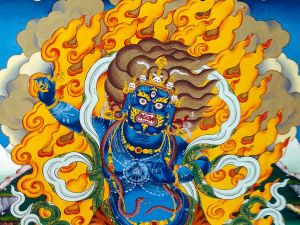What is Serkyem? What is its purpose? Why is it performed?
The Serkyem or Golden Drink offering, is part of Dharma Protector’s practice like that of Setrap Chen’s practice. In Tibetan,Ser means ‘golden’ and Kyem means ‘beverage’. Serkyem remains largely a unique aspect of the Dharma Protector practice. Lamas of the past developed this practice as an offering to the Dharma Protectors to request for swift assistance with obstacles, problems and dire needs.
Hence, the Serkyem offering has become popular among modern practitioners who seek assistance.
The Serkyem offering is offered by pouring the beverage into a cup like a wine glass, which is placed into a lower bowl.
The Serkyem offering or Golden Drink/Black Tea is offered from a jug, tea pot or any vessel that makes pouring easy.
During the offering, the beverage is poured into the cup to the point where the liquid overflows down into the lower bowl.
“In Buddhism, the symbolism of the overflowing liquid is highly auspicious because it represents an abundant flow of merits, virtues, material resources and conditions that are conducive for one’s Dharma practice.”
The beverage can be poured a little at a time during the recitation of relevant passages throughout the liturgy. “The Serkyem vessel can be of any material such as gold, silver, copper, brass or even glass. Offering vessels that are made of precious materials are considered highly propitious, especially for lay practitioners who want to create tremendous merits and establish the closest affinity with the Protector.”
The overflowing of Serkyem is symbolic of an auspicious offering to the Protector.
Black Tea is traditionally offered as Serkyem because in ancient times, it was considered a precious beverage. The colour of black tea is golden and reflects the meaning of Serkyem.
“When tea is offered, it is traditionally offered piping hot as a direct request to the Dharma Protector for the swiftest assistance, heat being symbolic of rapidity.”
Here, it must be noted that offering of cold tea should be avoided because of the reason stated above. Many Bhutanese prepare tea and than store in a bottle from where it is offered. A bottle of tea even last for a month. Tea is traditionally used but besides tea, beer or alcohol can also be offered because of the Tantric meaning behind such substances.
Alcohol of any kind is considered a wrathful substance, an example of this is during a Tsog offering, “a little bit of consecrated alcohol and meat is partaken to symbolize the psychic winds and bodily elements used in Tantric meditation; therefore beer or alcohol represents Tantric attainments and is offered to the Dharma Protector as a direct request to overcome all obstacles that obstruct spiritual attainments and to bring about beneficial conditions swiftly.”
Tea and alcohol are not the only beverages that can be offered as Serkyem, “milk, which symbolizes spiritual nourishment may be also offered.
The actual Serkyem offering ritual begins with the pouring of a little of the beverage into the vessel so it’s not empty.
“The Serkyem is consecrated with three repetitions of the mantra Om Ah Hum, while purifying with incense. Then, the Serkyem liturgy is recited with each stanza describing an offering of the Serkyem to a particular being or a class of beings that play a defined role in our spiritual practice.
During the offering, the Serkyem is visualized to be divine nectar that expands to fill an entire ocean. This ocean is made out of not just the beverage that the practitioner offered but of all the desirable things in the world that excite and please the 5 senses.
This vast ocean is offered to the Protector and to the other special beings mentioned in the liturgy. In addition, the request or what the practitioner wants to achieve is visualized to come into fruition with the assistance of the Protector.”
As stated above this is the typical practice that has been done in the monasteries over the ages due to its proven efficacy.
Source
[[Category:Tibetan Buddhism
